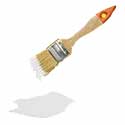Painting a ceiling with old-style whitewash

In the first part of the 20th Century, decorating living rooms and bedrooms meant replacing the existing wallpaper and painting the ceiling. This page is about preparing for and painting the ceiling, which was a very different activity than it is today. There was no emulsion paint, and the page elaborates on what had to be used instead, which was known as ‘whitewash’. There were no rollers for applying the paint, and the problems of using a brush on a ceiling are also described.
____
Extracted from the memoirs of the webmaster's mother (1906-2002) and edited by the webmaster with further research
When I was a child, early in the 20th Century, ceilings needed to be painted more frequently than today because of the soot and grime from coal fires. But painting ceilings was a major bother. As you read on, you will understand why.
What is whitewash and whitewashing
All that was available for painting ceilings was 'whitewash' which was made from slaked lime (calcium hydroxide) and chalk with certain additives. Fortunately, it was relatively cheap, but there the advantage ends. It was bought as a powder and had to be made up for use as paint by mixing it with water. This, in itself was hard work, as bucketfuls were required, judging the amount of water was critical and the mixing required a lot of stirring.
Preparing the room
For preparing the room, we did have dust sheets - which were normally old sheets - but there were no waterproof plastics. So the whole room had to be cleared before starting, including ornaments, pictures, mats and rugs. The venetian blinds also had to be taken down. From today's point of view, this may seem excessive, but read on and you will understand.
Preparing the room was the task for the women of the house.
Washing the ceiling before painting and why this was necessary
Ceilings had to be washed before applying the whitewash because old whitewash tended to flake off, and the flakes had to be removed before fresh whitewash was applied. This was the job of the man of the house because it needed strength and endurance.
Just imagine how the man had to contort his body to do this. It necessarily meant standing on a tall chair or a step ladder and rubbing forcefully where he could reach at arm's length, keeping his arm above his head. Then when one small area of ceiling had been washed, he had to come down and move the chair or step ladder to repeat the process on another small area of ceiling. There was no way to stop the dirty water running down his arm or the flakes going into his hair.
The painting process
Aching arms didn't finish once the ceiling was washed.
There were no rollers for applying the whitewash. It had to be painted onto the ceiling with a large brush - and brushes drip. So as much of the cold white liquid ran down the man's outstretched arm as ended up on the ceiling, not to mention the splashes on the floor. Throughout he had to cope with keeping his aching arm above the head and repeatedly getting down to move the chair or step ladder.
Clearing up the room
Afterwards the cleaning up began, but this was again a task for the women of the house. The numerous splashes had to be scrubbed off the floor and, once dry, the various mats, rugs, ornaments and blinds had to be replaced.
Using up leftover whitewash
If there was any unused whitewash, the man used it on a wall somewhere the looked as if it would benefit - walls being easier to paint than ceilings. Inside the house, walls were wallpapered, not whitewashed; whitewashed walls were in places like inside the outdoor lavatory and the garden shed. Afterwards he had to clean his brushes.
| sources | webmaster | contact |
Text and images are copyright
If you can add anything to this page or provide a photo, please contact me.



